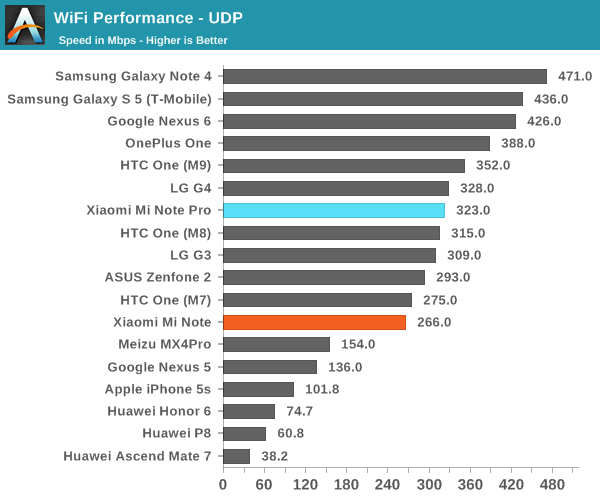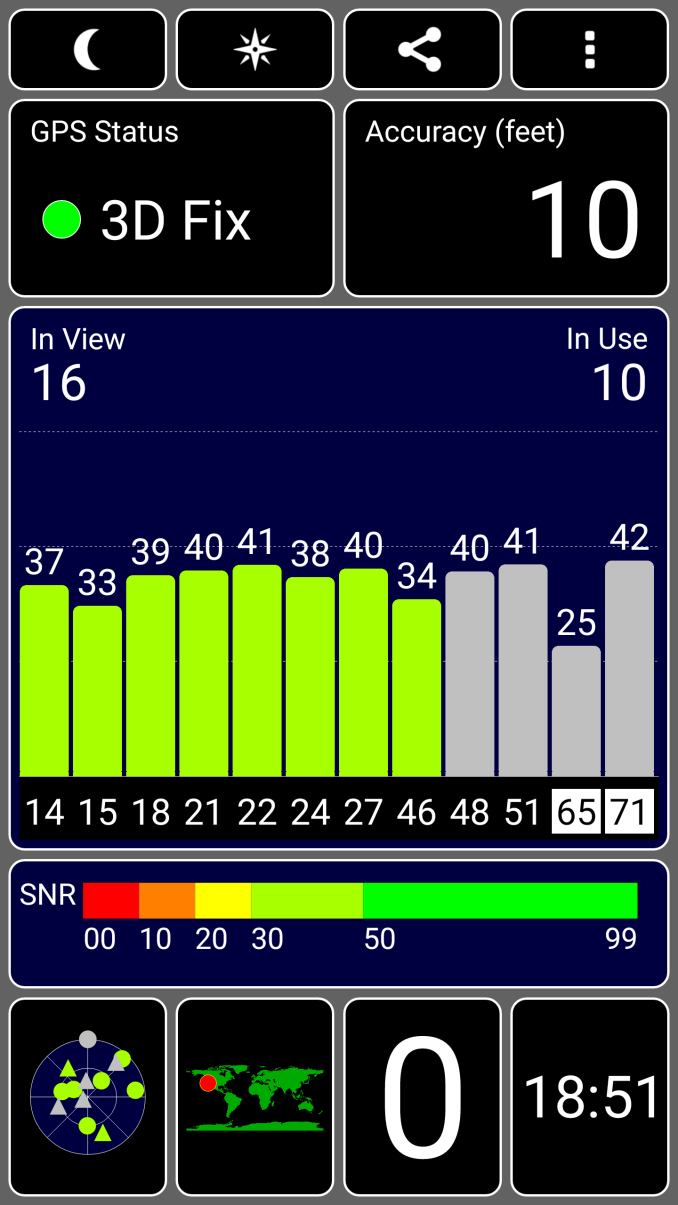The Xiaomi Mi Note Pro and Mi Note Review
by Joshua Ho on September 11, 2015 9:00 AM ESTWiFi Performance
Even though smartphones are usually considered to be necessary for their mobile data capabilities, smartphones and tablets tend to spend a lot of time on WiFi networks instead. As a result, it’s important to have a smartphone with good WiFi connectivity as otherwise there’s potential for poor bandwidth, connection reliability, and frequent drop-outs from a router. Anyone that has tried a smartphone with poor WiFi will probably understand just how frustrating all of these things can be. In order to try and approach testing a complex radio subsystem, we’ve settled for a relatively simple bandwidth test using iPerf to see what the maximum UDP download rate is on the device under test. In the case of the Xiaomi Mi Note, we see a Qualcomm Atheros WCN3680 WiFi chipset, and the Mi Note Pro appears to use a QCA6174 despite only enabling a single spatial stream.

Interestingly, the Mi Note Pro ends up with a higher peak bandwidth result than the Mi Note even though both are using a single spatial stream. I’m not sure what’s causing this, as performance between the two should be relatively as the main performance improvement from QCA6174 should be dual spatial stream 802.11ac. Either way, neither should have significant problems in everyday use of WiFi given dual band support and support for the latest standards.
GNSS
Location services are surprisingly important in a smartphone. Without highly accurate, reliable, and fast location fixes a number of applications in a smartphone would be difficult if not impossible to implement. Turn by turn navigation is easily one of the most common and critical location-based applications a phone will run, and poor GNSS performance is a good way to make sure it never gets used. In order to test this, we run a standard GPS information application and attempt to accurately track just how fast it takes for a phone to acquire a lock without any GPS assistance (airplane mode) and no pre-existing assistance data. In the case of the Xiaomi Mi Note phones, the GNSS solution is likely to be integrated into Qualcomm’s modem, which means that with any kind of mobile data connection time to first lock is on the order of 5 seconds.
Running the test previously described, the Mi Note line appears to achieve first lock in roughly 40 seconds, and almost immediately after first lock is acquired accuracy is at 10 feet. It’s actually quite rare for a phone to achieve this, as most phones usually take at least an extra 10-30 seconds to get down to usable accuracy levels once first lock is achieved. Received signal strength is quite strong with most satellites strongly in the 30 dB SNR range.
Misc
While we don't really have the necessary equipment to do audio right, I noticed a number of things on the Mi Note series that seems to set the Mi Note line apart from other phones I've tested recently in audio performance. The first thing worth noting is that the speaker gets painfully loud, to the point where I usually keep volume under half of the maximum. I normally keep something like the One M8 closer to 75-100% volume, so it's pretty safe to say that these phones can pretty much reach unsafe levels of volume if you want them to. There's also a Saber ES9018 DAC connected to the phone over i2c which is probably used for 3.5mm output, and the speaker's amplifier is driven by Texas Instruments' TAS2552 which can reach a maximum of 4 watts. The touch screen on both appears to be Synaptics' in-cell touch solution if you go by system files, but for some reason the ITO grid is still visible.











94 Comments
View All Comments
AussieinUS - Monday, September 14, 2015 - link
FYI my Note works in the USA and Canada with my US T-Mobile account. No LTE but HSPA and 3G. The same speeds that I got in Italy where it was purchased. The Bands in the Note is missing for LTE at least in the version I have. I think 1700. Also the slowness to update from Kitkat is a limitation. Overall a great phone and well priced.johnny_boy - Saturday, September 12, 2015 - link
Android 4.4 KitKat? Really? I wouldn't even consider the Note because of this. I have the Honor 6 and it's taking ages for them to bring their first OS update ever to the phone: apparently we got Lollipop late this month, around the time Marshmallow comes out! Definitely the last phone I buy from Huawei.realbabilu - Tuesday, September 15, 2015 - link
don't worry. They re updating the firmware fast. you can choose nightly every week update.I have oneplus that came with Lollipop CM12s still has the 3 stagefreight bugs, Xiaomi miui patched them fast with kitkat firmware.
The Lollipop Cm12s Oneplus is killing batteries faster than Kitkat Cm11s
vision33r - Sunday, September 13, 2015 - link
Note 5 and S6 Edge Plus reviews are everywhere. I've checked them out and they are super fast, I've never used an Android device that smooth and fast before. I definitely think those are the phones to beat in 2015. However I don't want them because like the iPhone 6 they are due to get refreshed next year when Samsung can finally figure out how to get microSD working. I can do without battery swap but I need ext storage.Yaru - Sunday, October 4, 2015 - link
I doubt Samsung will bring back MicroSD storage. They're targeting the high end premium market with those phones and they rather charge you extra money for extra internal storage like Apple does.NXTwoThou - Tuesday, September 15, 2015 - link
*crosses fingers that WM10 will be available for it or its successor*JimmiG - Wednesday, September 16, 2015 - link
Part of the difference in battery life can also be explained by Android 5.0 vs 4.4.4, since KitKat has superior battery life over Lollipop.hasseb64 - Monday, September 21, 2015 - link
Chinese hardware and STASI software, your personal info is SOLD at least two times...ntgeralt - Wednesday, September 23, 2015 - link
Tell you someting you don't know:In permissions management system, It will automatically scan all your files background and "tell" you how much crash you need to clean.And XiaoMi UI will give you ads push everyweek,you can't find anyplace to turn it off.
The last thing is google it: "XiaoMi backdoor".
pintin - Wednesday, September 30, 2015 - link
Yes.An important reason for the unexpected success of the company Xiaomi were designed both hardware and firmware that runs on the open source software of Android. Xiaomi MIUI interface of speed and design equivalent to the operating system of the iPhone or the Samsung's high-end products but with only half the price. Most Android phone vendors are dependent on similar designs by the third party manufacturers like Foxconn provide.